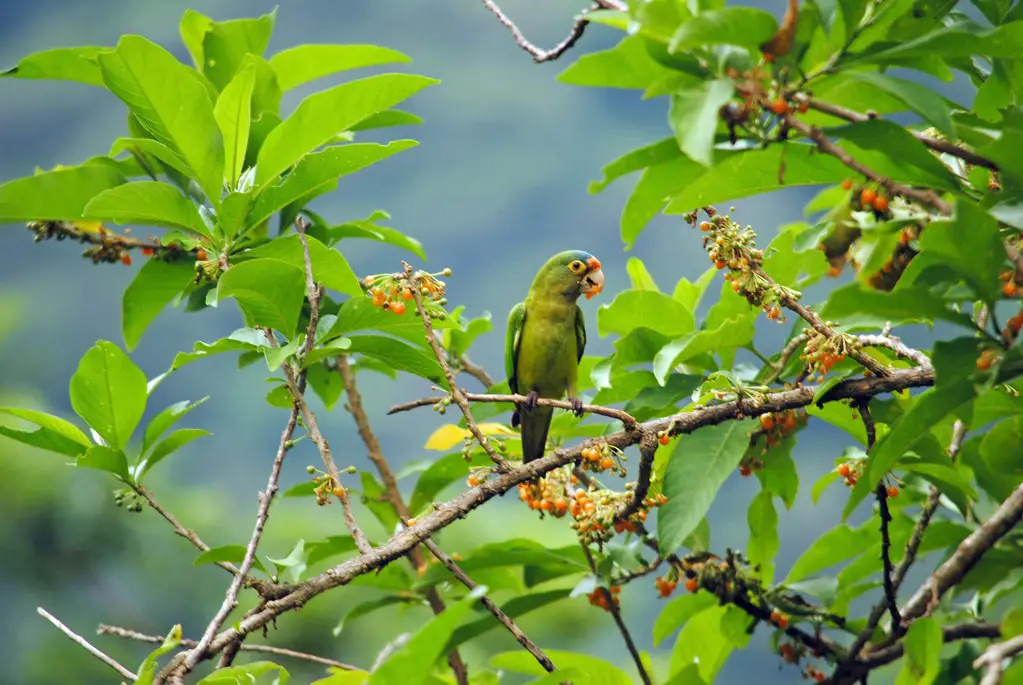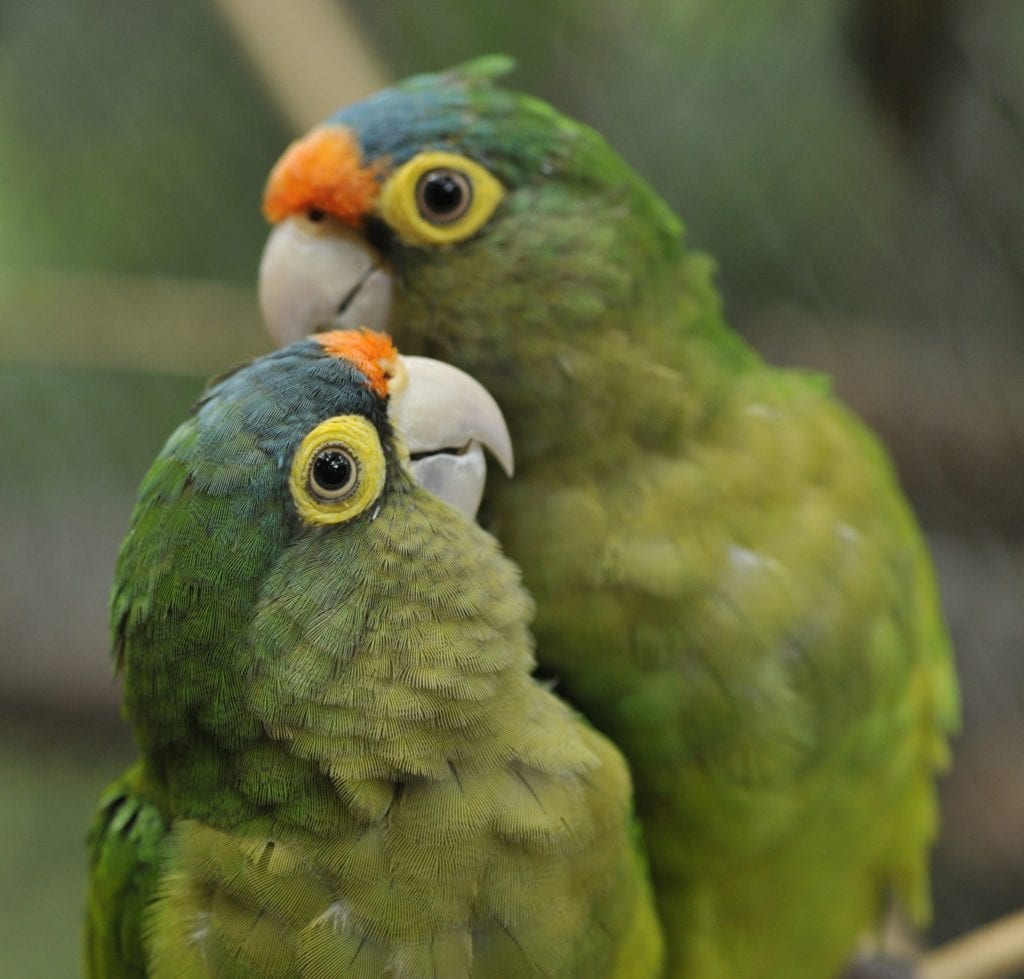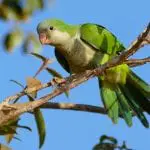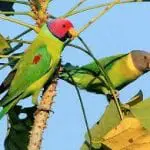Scientific Facts
| Common Name | Orange-fronted Parakeet |
| Scientific Name | Cyanoramphus malherbi |
| Life Span | 10-15 years |
| Size | 8.9 inches |
| Habitat | Beech forests, subalpine tussock Shrubland, short-lived woodland, and savanna |
| Country of Origin | South Island, Little Barrier Island, Hen Island, and North Island |

Physical Description
Orange-fronted parakeets are approximately 8.9 inches long and weigh around 80 grams. They are little, green, and long-tailed creatures with plumage in bluish tint. Their primary coverts, as well as their outer primaries, are azure blue. The frontage band over the eyes, as well as the patches on both sides of the rump, are tinted with orange, and the crown is in lemon yellow. Male parakeets are observed to have brighter colors compared to female parakeets. The young ones are paler, particularly the crown patch and the frontage band.
Lifespan
Orange-fronted parakeets can live for 10-15 years. Nevertheless, the duration of their living is still dependent on the environment they are exposed to. If owners are taking care of them properly, they are likely to live longer.
Eating Habits

Orange-fronted parakeets commonly feed at the top of towering trees. However, they are also seen in low vegetation or the ground. They feed on shrubs and trees. They eat fruits of several kinds like mulatos and figs, seeds of Inga and Ceibas, and flowers of Combretum and Gliricidia. They primarily feed on flowers and fruit; however, outside the season of breeding, huge flocks have been recognized to create damage to ripening and maize bananas. Every Orange-fronted parakeet arrives at their feeding venues by groups, which typically slaughter the available food. Hence, they are considered as pests on plants, particularly in plantations of banana ripe and maize.
Sleeping Habits
Parakeets require enough sleep to maintain their healthy condition. At least 10 to 12 hours of sleep would be enough for these birds. The cage is normally covered with a piece of cloth to make the environment dark and for the parakeets to feel secure. Naturally, parakeets are nesting in hollows they chew out of Eucalyptus trees.
Parakeets also take a nap during daytime if the surrounding is quiet. They commonly yawn and stretch before finally falling asleep, or once they wake up.
Development and Reproduction
Orange-fronted parakeets are free to breed any time of the year. However, their primary nesting period runs from December to April, while incubation culminates in January. The average clutch size is around 7; however, a huge range has also been noted.
The laying of the egg is nonparallel, with a 2-day interval between eggs. The incubation period consumes 21 to 26 days, while the nestling period stays for 35 to 45 days. Female parakeets happen to select the venue of the nest and go into the entire preparation, including the incubation and brooding. Male parakeets are the ones that provide the female’s food, particularly during the period of incubation. Nevertheless, females frequently abandon the nest to quickly feed with the male. It is believed that only the female parakeets nourish the nestlings during the first 10 to 14 days. Once this period is over, both the adult male and female are said to feed the nestlings.
Multiple clutches are not unusual. If the first try for nesting is not successful, then the pair is expected to nest again the moment they see an appropriate hollow. Certain pairs can breed 3 to 4 times in continuity when there is a portion of abundant food, such as during the event of beech seeding. The female parakeet can lay another clutch once the initial nestlings are around 2 weeks old. With this, the male parakeet is left to be the only producer for both the incubating female and the nestlings.
Nests are commonly impregnated with knot holes, most commonly in the trunk of a tree or huge branches. They generally nest in standing barren trees and red beech, however, other beech species are utilized too. Nest bowls may be aligned with the entry of the hollow, or through a meter deep. The reported height of the nest differs from 2.5 to 26 meters.

How to Breed
Determining the Sexes
As long as the orange-fronted parakeet reaches 6 weeks old, one can easily determine the sex of his pet by checking on the little rim of the skin over the beak. If you notice the skin to be darker, the parakeet you are checking is a male one. However, if you notice the skin of your pet to be lighter, the parakeet is a female one.
Courtship and Mating
Their voices are commonly resounding chatter calls, of different length and concentration. If two parakeets are together, gentler contact calls are typically heeded, sometimes other than the churning and squeaking. These calls are done during courtship feeding and copulation. Calls are relatively unique and composed of single annotations.
Courtship feeding is not sexually stimulated. Instead, it is a way of administering the pair connection. In a usual behavior of courtship feeding, two parakeets perch next to each other. One may gnaw the perch, or they can alternately gnaw the perch, wipe or rub its mandibles facing the perch, or head-bobble. These activities can sometimes arouse the partner.
Eggs and Incubation
They primarily nest in self-burrowed cavities in branchy termitariums. The size of the clutch is 3 to 5 eggs, which are then incubated for around 1 month by only the female parakeet. The young fledge after around 5 weeks.
Caring for Hatchlings
The eggs shall start hatching within 18 days and may begin to hatch before the female is done with laying. In some cases, she will identify that there are young to take care of and jolt eggs away from the nest. If extra care is provided for the eggs and even move out some if needed, there is a chance that you can keep a higher number of hearty baby parakeets.
Common Health Problems
Poor Nutrition
Parakeets cannot survive with seeds only. Pellets, complemented with vegetables and fruits, are perfect. A lot of seed diets have insufficient vitamin A, protein or minerals, and parakeets formed nutritional deficiencies that require veterinary attention. Parakeets need vitamin A because it is essential for their red blood cells, vision, and a hearty immune system. Phosphorous and calcium are also important to keep the bones healthy. Maintaining the functionality of the immune system, together with a balanced diet, will help parakeets avoid health issues.
Parasites
Parasites, whether internal or external, cause numerous health problems for parakeets. Protozoal parasites like trichomonas can infect the throat of the parakeet and trigger medical issues such as sneezing, low appetite, and coughing. Lice or external mites cause crusty skin, feather loss, itching, and sometimes anemia. Parakeets affected with intestinal worms such as threadworms, hairworms, or roundworms will often experience depression, weight loss, and overall ill health.
Injury and Toxins
Knowing that parakeets are inquisitive creatures, they can go into places where they do not belong. Such exploration may lead to body injuries, digestive upset, and poisoning. Parakeets may ingest small things such as plant food, rodent poison, salt, and prescription pills. Noxious poisoning through these kinds of stuff directs to health issues such as diarrhea, difficulty in breathing, vomiting, seizures, and death. Some plants can be venomous, as well as air fresheners, fumes from cookware, cleaning products, paint, and tobacco.
Diseases
Diseases create an array of medical issues among parakeets. Chlamydia psittaci, a kind of bacterial disease, is transmitted between birds and maybe spreading to men. It triggers respiratory medical concerns. Viruses like the beak and feather virus, avian influenza, or avian polyomavirus trigger medical issues such as pneumonia, diarrhea, and abnormal feathers. Poor hygiene and malnutrition make it possible for the aspergillus fungus to infect the nasal cavity of the parakeet, which triggers congesting and sinus swelling.
Preventing Illnesses
Taking care of your parakeets shall bring the least chance of them getting ill. Feeding them with a balanced diet is an important factor that keeps them healthy. Other than the ideal diet, parakeets also love to tickle in the rare treats. Particularly when it is feeling lonely or scared, treats the act as a fast and efficient way of comfort. Some treats are popcorn, honey sticks, and grape slices.
Toys can also keep the parakeets busy and far from trouble. They love to play with various toys. It is necessary to switch the toys and clean them with warm water and soap at least once a week to prevent health concerns.
Behavior
Orange-fronted parakeets feed in a group that can come to 100 birds outside the season of breeding, taking different seeds, fruits, and flowers. They are normally quiet and hard to notice. Their presence is mostly identified through their raucous chatter or silent contact call. However, tracing the bird may be hard. Their flight calls are a loud can-can-can, and if perched, it has a stringy zeeweet.
Habitat
Cage
A proper cage should be used. As much as possible, use the biggest cage possible because that would give your parakeet a lot more convenience. Set up the horizontal dimension because parakeets fly in a horizontal approach rather than vertical. It should be built from stainless steel. Other metals like brass, lead, or zinc can be harmful to the parakeets.
Perches
Equip the cage with perches. The best selection for perches are branches coming from natural orchard wood. Preferably, select a branch diameter that is sufficiently large so that the toes of the parakeet will not curl around and overrun each other. Orchard wood like cherry, apple, pear, or plum is safe for the bird to bite at it. It also has naturally scraping action that helps to trim the nail.
Toys
Parakeets have cheerful, curious minds and require a lot of mental incitement. Place a collection of toys inside the cage so that your parakeet can have something to play with. Toys that are greatly adored by parakeets are bells, mirrors, or ladders for their climbing. However, toys need to be safe for the bird and should provide entertainment. Boredom may lead to screaming.
Diet
Orange-fronted parakeets feed on invertebrates such as caterpillars and insects. They also eat buds, seeds, and flowers. During a mast year, seeds turn to be the primary ingredient in their diet and seem to be the primary food for the nestlings. Invertebrates happen to execute a bigger role in the diet of orange-fronted parakeets. This will probably explain why these birds are frequently noticed together with the insectivorous birds.
How to Care for Orange-fronted Parakeet
Orange-fronted parakeets are fun and great pets to have. They do not require so much maintenance that even beginners can manage to handle them. To care for an orange-fronted parakeet, it is important to provide them company. If you only have one parakeet, the use of a mirror is practically important. A single parakeet will appreciate your company; however, a mirror can help them feel a bit alone.
A balanced diet must be provided to the parakeet. Make sure to serve your pet with varied foods. Pellets are great for their diet, but you should complement it with fresh vegetables and fruits.
Availability – Where to Get One
Orange-fronted parakeets are available in pet stores. You can also get them from breeders. These creatures are perfect pets to have. More to being a pet, these creatures can give you joy because they are naturally charming. However, when getting an orange-fronted parakeet, make sure to buy it from a legit seller. The seller should be knowledgeable about the bird. Otherwise, you should consider finding another seller who can give you relevant information about the bird.
FAQs
I often leave for work, will that make my parakeet sad?
Orange-fronted parakeet loves your company. She will feel sad if you cannot be around. However, you may use a mirror to lessen this sadness. Your pet will somehow find joy playing with that mirror.
It is my first time to take care of a parakeet, can I do it?
Even the beginners can easily handle an Orange-fronted parakeet. This creature does not require so many technicalities. What is important is you secure its basic needs, which are a balanced diet, a clean environment, enough exercise, and playtime.
Should I buy another parakeet to accompany her?
Giving your parakeet a company would be a good idea. That way, your pet won’t get bored, and it will feel happy.


